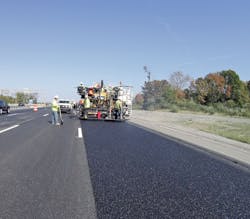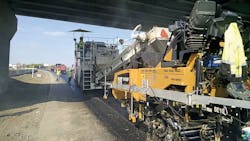By: Brian W. Budzynski
Construction projects in dense urban or suburban areas are among the most crucial to our national infrastructure, yet they also tend to be the least applauded.
There are no gorgeous vistas to consider in photographs, no access offered on completion to theretofore unreachable beauties. Mostly, people just get to work quicker. Yet this characteristic should never be underestimated in its value. Nor should the value of a job—any job—well done.
It was with this simple goal in mind—a job well done—that Milestone Contractors LP, in partnership with the Indiana Department of Transportation (INDOT), undertook the full-depth reconstruction (FDR) and expansion of a 3.4-mile segment of I-65 just south of Indianapolis, and as a result earned the National Asphalt Pavement Association’s (NAPA) Quality in Construction Award.
Rubblizing the old road.
Making the investment
The Indiana General Assembly set aside $400 million in the 2014-2015 state budget for the “Major Moves 2020” trust fund. During the 2015 legislative session, INDOT successfully argued that the funding would be better invested in widening and rehabbing existing interstates. As a result, I-65 was one of six projects recommended after INDOT studied interstate congestion, pavement condition and bridge condition data. Ultimately, an investment was made, to the tune of $35 million, to revitalize this piece of the corridor.
The project was located on the south side of Indianapolis and bridged two counties, between Southport Road (MM 103.2) to County Line Road (MM 100.8) in Marion County, and from County Line Road to Main Street (MM 99.2) in Johnson County. The project impacted northbound (NB) and southbound (SB) directions of travel, as well as three interchange locations, which serve major commercial and industrial zones.
“We had a lot of different traffic patterns, as you might imagine, due to the interchanges and volume of traffic,” Dave Speer, general Indianapolis area superintendent for Milestone Contractors LP, told Roads & Bridges. “There’s quite a lot of truck traffic on this stretch, shipping and hauling in and out. We wound up having five phases of traffic management as a result.”
Removing the old base to reach the dirt.
Maintaining control
According to INDOT Project Engineer for the Greenfield District Mike Wilmot, traffic phasing was key to the project.
“I-65 is a six-lane interstate with heavy traffic. The pavement needed to be demolished, removed and replaced while disrupting traffic as little as possible. The plans allowed different lane configurations for different phases of the project,” Wilmot told Roads & Bridges. “Initially we pushed all traffic to the inside and worked on the outside. That’s where we did our widening, both NB and SB. Then we moved to the interior lanes. Traffic control was a 3-2-1, where we had three lanes on the outside, and two lanes from the opposite direction and a single lane for local traffic on the far outside. We had to coordinate with other projects adjacent to our work site, which added a challenge, but there was always communication with my counterpart on the other projects. And Milestone also was the prime on one of the other projects as well, which made it a bit easier than otherwise.”
The project architecture consisted of three 12-ft mainline travel lanes, with an outside auxiliary lane added in both NB and SB directions between the following locations:
- NB between the Main Street entrance ramp and County Line Road exit ramp;
- NB between the County Line Road entrance ramp (loop) and Southport Road exit ramp;
- SB between the Southport Road entrance ramp (diagonal) and County Line Road exit ramp; and
- SB between the County Line Road entrance ramp and Main Street exit ramp.
Crews maintained six lanes of traffic at all times.
The auxiliary lanes were constructed 12 ft wide with a 10-ft paved, 11-ft usable outside shoulder. A 36-ft inside median, which included an 8-ft paved shoulder with double-faced guardrail to separate NB and SB travel lanes was maintained. The typical section for all interchange ramps consisted of a single 16-ft lane with a 4-ft paved, 5-ft usable inside shoulder and an 8-ft paved, 9-ft usable outside shoulder.
“Basically between the ramps, we made that a continuous lane,” Wilmot said. “An auxiliary lane, rather than a through lane.”
In order to maintain a steady pace—which was a difficult enterprise, as the construction window of April through November 2015 saw an unusual amount of rainfall, according to both Speer and Wilmot—and to keep the corridor viable while the work was ongoing, INDOT specified a level of accessibility.
“We had to maintain six lanes of traffic at all times,” Speer said. “So we strengthened the shoulders on the NB side and moved one lane of SB onto the NB side. And then worked on the outside. And then we flip-flopped it. We split it into 1-mile sections, give or take. We initially didn’t plan to work 24/7, like we did. We were going to work 24/6 and give the guys Sunday off, but we were 40 days behind when the rains finally let up at the end of July. We had to hit it hard from there out to get it done right.”
Crews designed and laid five total lifts.
Down to the dirt
Work opened with a complete removal of the existing pavement, which consisted of approximately 4-6 in. of asphalt over 12 in. of continuous reinforced concrete pavement. The asphalt was milled off using milling machines to expose the underlying concrete, which was then pulverized by pavement breakers. The reinforcing steel was separated from the concrete debris during the removal process using track excavators.
“We removed it all, took every little bit of it out,” Speer said. “We took it down to the dirt. We milled all the asphalt off so we could reuse it. We ran it back through the plant to use some of it on the mainline, and we also used some on the shoulders. We do a 40% binder replacement on the recycled asphalt pavement (RAP), which also employed some recycled asphalt shingles (RAS), just under 5%. INDOT allows up to 5% RAS, but we didn’t go up that high. ”
Once the dirt was exposed, Milestone found itself in a pretty good position. “There were some grade changes but not a lot,” Speer added. “We tilled and Soilcreted the dirt to stabilize it in place, and then paved on top of that.”
In order to finish with a road both strong and durable, Milestone employed multiple mixes and lifts, from the dirt on up to the final wearing surface. The bottom layer was a 25-mm aggregate (agg) that included RAP with a PG 58-28 binder, put in at 4 in. This was followed by a 19-mm open-graded material (OG) drainage layer that used a PG 76-22 binder, at 2.5 in. The base layer was, again, 25-mm agg, this time with a PG 70-22 binder, at 6 in. The penultimate, intermediate layer was 19-mm agg with a RAP blend and a PG 70-22 binder at 3 in. Finally a steel slag surface, incorporating a PG 76-22 binder, was used for the 1.5-in. wearing course.
During the entire multi-month work period, testing was done on a steady schedule.
“We did our own testing at the plant,” Speer said. “Truck samples first thing in the morning to assess that volumetric properties were correct. Also, Indiana does plate testing, which means you place the plates out on the road, pave over them and then pick up the plates. Those are how your pay is based.”
A Roadtec Shuttle Buggy transfers asphalt mix to a Caterpillar paver.
Milestone Quality Control Manager Brad Cruea described the process: “We drilled a hole out on one end of the plate and tapped in a concrete nail to keep it steady when the paver goes over it. Then we tied cables to it, which extended out either side of the screed. After they were paved, we pitchforked them up, and we have what we call ‘pizza boxes’ in which we transported the plate samples for testing.”
“We would take a plate sample on the fifth load every morning,” Speer said, “and then the rest on random hauls, according to INDOT request. We achieved the volumetrics we needed, and we earned the bonus on it,” a fact Wilmot confirmed.
“Plate samples were used to sample the mix placed on-site,,” Wilmot said, “and cores were used to determine density. INDOT performed all testing for acceptance. Milestone received an incentive of $166,242.98 for mix and density.”
Crews were able to keep the work simple by leaning on select pieces of machinery. Following a Roadtec 2500 Shuttle Buggy, a duo of Cat AP1055F and AP655F pavers laid down the entire stretch of road. Compaction equipment was segregated by lift layer. In a series of 5-7 passes, depending on temperature, a pair of Cat CB54 XW rollers on vibe mode handled the sub-surface layers, while Ingersall-Rand weighted static rollers finished off the topcoat.
Finalizing and safety work was literally rolled into the paving process.
“One of our challenges was inlaid striping,” Speer said, “which you either have to roll in as you’re paving or mill it in afterwards. There’s temperature requirements with that. It can’t be below 50° for 24 hours after they are installed. We had to do them as we paved. We didn’t have the option of doing them after the fact. It’s a preformed tape for the edge and center lines. It binds to the aggregate. Doing it that way changes your planning in terms of how you’re going to pave it, because afterward you can’t bring traffic back on in a pattern other than what its normal traffic pattern will be. Over the last several years, INDOT has seen snow plows being very hard on the paint, so they’re hoping this alternative will help, that it will keep longer.”
The completed project, open to traffic.
Meeting goals
Indiana does not as yet have a statewide spec for smoothness, but Milestone decided to satisfy itself on that score by employing an outside entity to assess their work’s IRI.
“We were curious,” Speer admitted. “We have a sister company in Illinois which does have an IRI requirement, called Open Roads, and they came over to run it for us. Our average was 32.74 according to Illinois DOT specs.”
It was a curiosity that paid off, according to Wilmot.
“Smoothness was verified using a profilograph,” he said. “Payment was adjusted based on smoothness. Based on the profile index, the contractor could receive 96% to 106% payment based on smoothness. They wound up earning an incentive of $432,309.09 for smoothness.”
When all was said and done, this segment of I-65 was given a new, long life, and the quality of the work, along with the successful collaboration between contractor and agency, was not lost on NAPA.
“The goal of every paving contractor is to build a high-quality road—a road that meets and exceeds stringent performance requirements,” said 2016 NAPA Chairman Kevin Kelly.
“Earning a Quality in Construction Award shows a strong commitment to quality from a contractor who measures their project against industry best practices. In earning this Quality in Construction Award, Milestone Contractors has constructed a safe, quiet, smooth asphalt pavement.”
In other words, a job well done.
About The Author: Budzynski is managing editor of Roads & Bridges.









